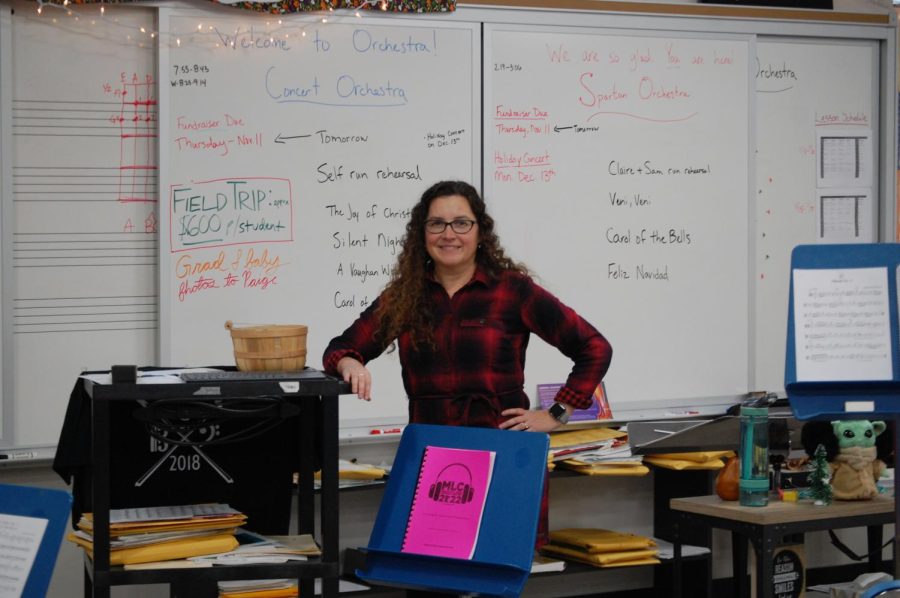Since the dawn of time to now: MUSIC
Board of Director/Music Listening contest coach Amy Eichers stands in the front of her Orchestra room at Superior High School.
January 26, 2022
A competition called the Music Listening Contest has been challenging students all around the United States. The students learn about the impact musical composers carved for all kinds of musical pieces, highlighting specific music for different times in history.
This competition was first established in 1987 by the Author of The Arts and Critical Thinking in American Education Doctor Ivan Olson. He persuaded the Minnesota state university system to fund a program that would educate high school students in discovering the history of music and understanding the process in which musical composers made their music.
“It is very competitive and it’s a lot. This is stuff that students take on, it is not part of a class or anything, it’s just something extra that they do because they want to learn more about history and about music. Gives you a chance to learn about the history of our civilization but through the lens of music rather than social studies,” Board of Director/Music Listening contest coach Amy Eichers said.
This will be the third year for the high school in which they will participate in the contest. The contest requires three students in a group and the group has to pay a $100 fee when registering. The high school will have a total of three teams that are going to represent the high school in the music listening contest.
“So the students have to listen to all of the pieces that are on the list and study them and be able to identify them in a drop of needles type of contest. One of the rounds in the contest is they’ll play anywhere from ten to thirty seconds of a piece of music, anywhere from the piece of music, not just starting at the beginning, anywhere,” Eichers said.
Each team works within their group and figures out who amongst the three teammates is responsible for learning specific musical time periods. There are a total of 52 musical pieces that the students have to learn as well as memorizing which composer wrote which piece and how to spell both. The music derives from 476 to the 21st century.
The contest hosts five rounds all directed toward what the student learns in the study guide that is provided to them. Each round requires students listening to a 10-30 second except round four which is answering multiple choice questions based on the study guide. Each round is worth 20 points, thus making the highest score possible to receive at the contest 100 points.
The judges will determine the two teams that have the highest points. They will head on to the championship contest.
Studying music as well as learning the composer who made the music are all very difficult and challenging tasks to do. It’s not easy learning all this stuff. It takes time and a lot of dedication in order to ensure that the students do their part to make their teams successful. Coach Eichers would help ensure that by using club time in order to help the students in whatever way she can so that the students can be experts with this type of information and ultimately do great in the contest.
“So this year with our club time, we’re using Thursday club time to go through and start to listen and we highlight, we read as we’re listening, we read about the piece and we highlight stuff that we think is significant that [the students] think ‘this is a question that they could ask,’” Eichers said.
Senior Ely Hanson talked about how during the whole preparation process of the contest, understanding the composer’s passion and emotion was a great way for them to learn the music.
“I’ve gotten to listen to a lot of interesting music, from different time periods and from different composers… My favorite part was seeing the difference in time periods and how you almost get the sense that composers were trying to fit into the time periods almost,” Hanson said.



